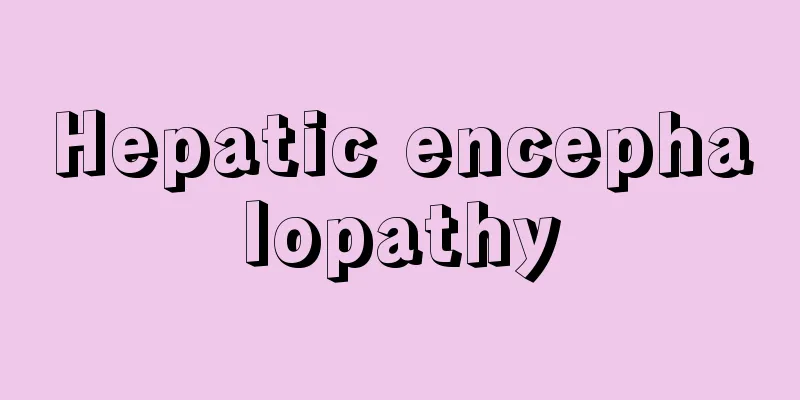Hepatic encephalopathy

|
(1) Hepatic encephalopathy Concept: Mental and neurological symptoms such as impaired consciousness caused by metabolic abnormalities associated with severe liver dysfunction, and are broadly classified into acute and chronic types. [See also 9-1-4)] Clinical symptoms: The acute type is typified by fulminant hepatitis, and is a neurological symptom associated with acute liver failure in which widespread liver cell necrosis occurs acutely (within 8 weeks). It begins with acute hepatitis symptoms such as fatigue and loss of appetite, and is accompanied by liver failure symptoms such as jaundice, tachycardia, and low blood pressure, as well as impaired consciousness, asterixis, dysarthria, extrapyramidal signs, pyramidal signs, and ataxia. The chronic type is a neurological symptom associated with chronic liver disease such as liver cirrhosis, and symptoms often fluctuate and recur. The main symptoms are impaired consciousness, psychiatric symptoms (in the early stages, impaired memory, disorientation, and emotional variability; with prolonged progression, dementia and personality disorder), movement disorder, and asterixis. In chronic disease , neurotoxic substances such as ammonia produced in the intestine are not detoxified in the liver, but pass through the shunt and reach the systemic circulation directly into the brain. The causes of hepatic encephalopathy caused by ammonia include a decrease in ATP production via the TCA cycle, involvement of the serotonin system in the brain, and involvement of glutamine produced in ammonia metabolism, but many aspects remain unknown. There are also reports indicating the involvement of mercaptones and aromatic amino acids other than ammonia, but the details are unknown. In acute disease, in addition to hyperammonemia, autopsy cases and imaging diagnostics have suggested the involvement of cerebral edema. DiagnosisIt is diagnosed from blood data indicating liver failure, high blood ammonia levels, a decreased branched-chain amino acid/aromatic amino acid ratio (Fisher ratio), electroencephalogram (EEG) findings, and clinical symptoms. The electroencephalogram closely reflects the severity of hepatic encephalopathy, with alpha waves becoming slow and irregular in the early stages, followed by high-amplitude theta waves of 5-7 Hz spreading throughout the brain from the front to the occipital region. In the precoma stage, a unique finding, triphasic waves (Figure 15-12-1), appears symmetrically, predominantly in the frontal region, but disappears in the coma stage. Additionally, T1- weighted images of brain MRI reveal high signal areas in the basal ganglia, centered on the globus pallidus. Treatment In acute cases, acute liver failure is treated, and mannitol or glycerol is administered to treat cerebral edema. In chronic cases, causes of elevated blood ammonia (excessive protein intake, constipation, gastrointestinal bleeding) are removed, and lactulose or lactitol is orally administered. If this does not result in a decrease in ammonia levels, antibiotics such as neomycin or polymyxin B are administered. Branched-chain amino acid preparations are effective in awakening consciousness and preventing encephalopathy. [Nakazato Masamitsu] ■ References Bismuth M, Funakoshi N, et al: Hepatic encephalopathy: from pathophysiology to therapeutic management. Eur J Gastroenterol Hepatol, 23: 8-22, 2011. Triphasic waves seen in hepatic encephalopathy "> Figure 15-12-1 Source : Internal Medicine, 10th Edition About Internal Medicine, 10th Edition Information |
|
(1)肝性脳症(hepatic encephalopathy) 概念 高度の肝機能異常に伴う代謝異常によって生じる意識障害などの精神神経症状で,大きく急性型と慢性型に分類される.【⇨9-1-4)も参照】 臨床症状 急性型は劇症肝炎に代表され,急性(8週以内)に広範囲の肝細胞が壊死に陥る急性肝不全に伴って認める神経症状である.倦怠感,食欲不振などの急性肝炎症状で発症し,黄疸,頻脈,血圧低下などの肝不全症状とともに,意識障害を中心として,羽ばたき振戦,構音障害,錐体外路徴候,錐体路徴候,運動失調なども認める.慢性型は肝硬変などの慢性肝疾患に伴って認める神経症状で,症状の変動や再燃がしばしばみられる.おもな症状は意識障害,精神症状(初期には記銘力障害,見当識障害,感情の易変容性,経過が長くなると認知症や人格障害),運動障害,羽ばたき振戦などである. 病因 慢性型では腸管内で生じるアンモニアなどの神経毒作用物質が肝で解毒されずにシャントを通って大循環を経て直接脳内に達する.アンモニアが肝性脳症を引き起こす原因としてはTCA回路を介するATP産生低下,脳内セロトニン系への関与,アンモニア代謝で産生されるグルタミンの関与などがいわれているが不明な点も多い.アンモニア以外のメルカプトン,芳香族アミノ酸などの関与も示す報告もあるが詳細は不明である.急性型では高アンモニア血症に加えて,脳浮腫の関与が剖検例の検討や画像診断からいわれている. 診断 肝不全を示す血液データ,血中アンモニアの高値,分岐鎖アミノ酸/芳香族アミノ酸比(Fisher比)の低下,脳波所見,臨床症状から診断する.脳波は肝性脳症の重症度をよく反映し,初期にはα波の徐波化,不規則化,その後5~7 Hzの高振幅θ波が前頭部から後頭にかけて全体に広がる.前昏睡期になると特異的な所見である三相波(図15-12-1)が前頭優位,左右対称性に出現するが,昏睡期になると消失する.また,脳MRIのT1強調画像にて淡蒼球を中心にして大脳基底核に高信号域を認める. 治療 急性型では急性肝不全の治療とともに,脳浮腫の治療としてマンニトールやグリセロールの投与を行う.慢性型では血中アンモニア上昇の誘因(蛋白の過剰摂取,便秘,消化管出血)の除去,ラクツロースまたはラクチトールの経口投与を行う.それでもアンモニアの低下をみない場合はネオマイシン,ポリミキシンBなどの抗菌薬の投与を行う.分岐鎖アミノ酸製剤は意識覚醒効果や脳症の予防に有効である.[中里雅光] ■文献 Bismuth M, Funakoshi N, et al: Hepatic encephalopathy: from pathophysiology to therapeutic management. Eur J Gastroenterol Hepatol, 23: 8-22, 2011. 肝性脳症でみられる三相波"> 図15-12-1 出典 内科学 第10版内科学 第10版について 情報 |
<<: The Three Eccentrics of the Kansei Era
>>: General Agreement on Tariffs and Trade
Recommend
Weapons industry
This is an industry that researches, develops, pro...
Atriplex
...an annual plant of the Chenopodiaceae family (...
Five Articles of the Law for the Nobles
…Ieyasu exiled the female court attendant to Niij...
Seminario
Means seminary in Portuguese. An educational insti...
Jionji Temple
Jionji Temple in Sagae City, Yamagata Prefecture i...
Leys, H. (English spelling) LeysH
… The fact that David, the leader of French neocl...
Qutlugh
…In this area, among the ten tribes of the Wester...
Corporate Responsibility
This refers to the responsibility of a company to ...
Serpukhov (English spelling)
A city in the Moscow Oblast in western Russia. It ...
Corned beef - konbi-fu (English spelling) corned beef
A type of salted beef product. Until the 17th cen...
Agnolo Bronzino
Italian painter. Born in Monticelli near Florence...
Iberian alphabet
…the Iberian alphabet is a combination of Greek a...
Vitality - energy
〘 noun 〙① The power that is the basis of activity....
Tithonos (English spelling)
A character from Greek mythology. He was one of th...
Tucher
…However, because linen and woolen production was...









